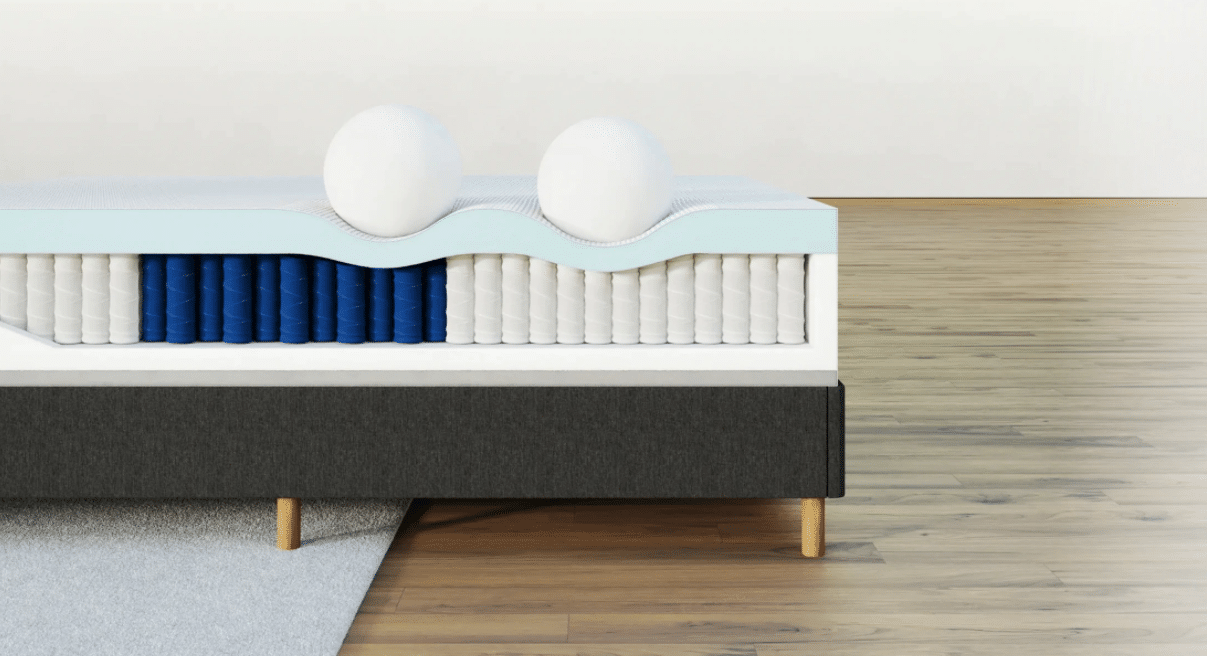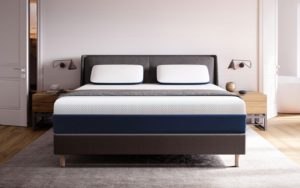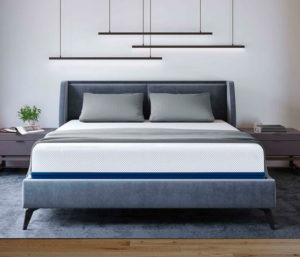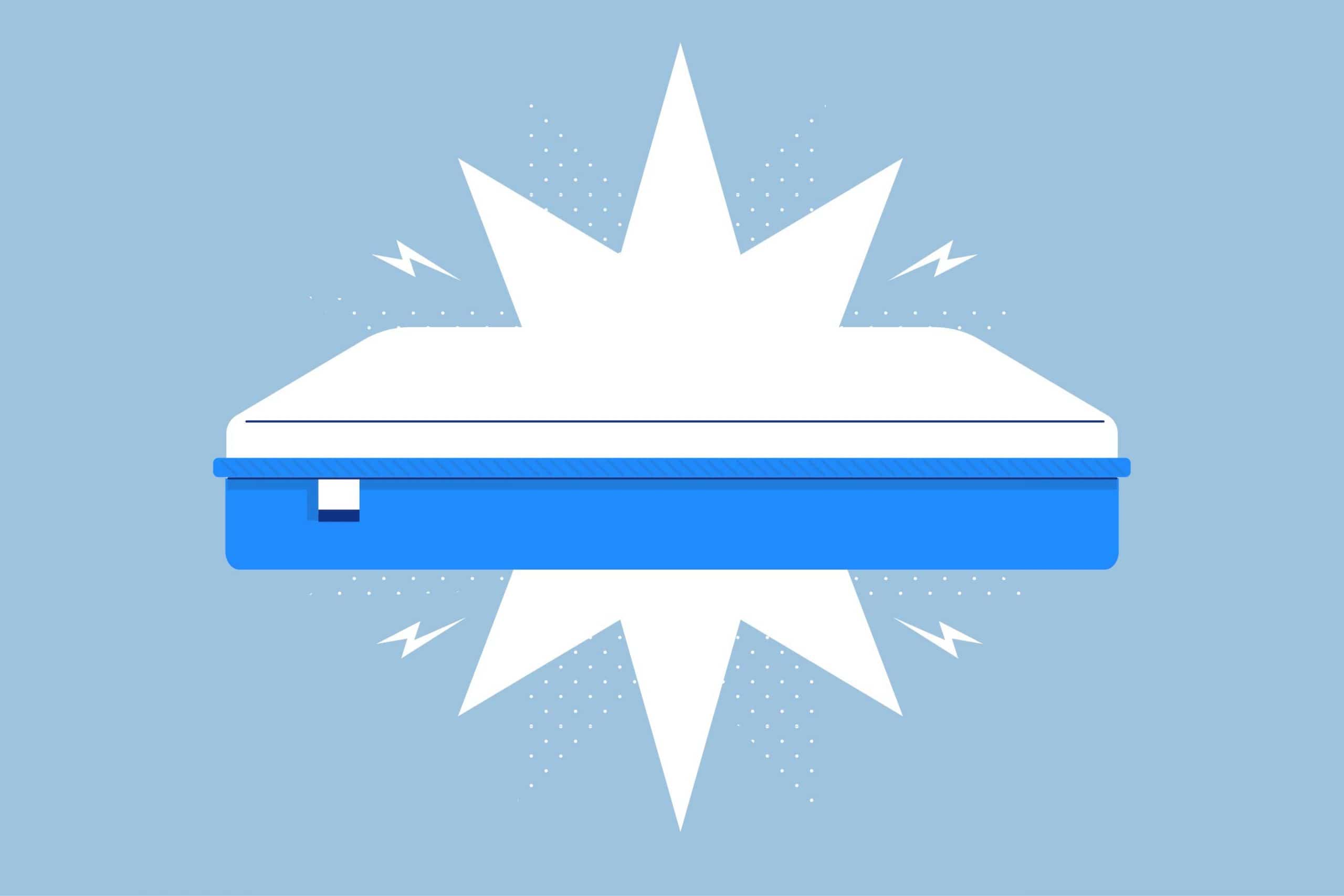Despite their name, hybrid mattresses have little to do with being green or eco-friendly, like hybrid cars. Hybrid mattresses combine two very different mattress materials into one, creating a mattress for those who want the pressure relief and conformity of memory foam with the bounce and cooling airflow of innersprings.
If hybrids seem like a new idea to you, our guide will go over all the pros and cons of using one, who is best suited to use them, as well as the average cost compared to other mattress types.
Hybrids are best for anyone who likes the contouring ability of memory foam without the heat build-up and the springy responsiveness of springs without the motion transfer. In short, hybrids are the best of the two most popular mattress types in one mattress.
Amerisleep AS2h – Best Firm Hybrid Mattress
Like Amerisleep’s AS2 mattress, the AS2h is a medium-firm mattress that is ideal for back and stomach sleepers. The addition of the spring coil base in this bed gives it a bounce similar to an innerspring bed.
The AS2h features a lightweight, breathable cover that keeps air circulating through the mattress. It keeps you cool and helps you wake up feeling refreshed night after night.
The Bio-Pur® foam in the comfort layer is an advanced open-cell foam with better breathability and responsiveness than traditional memory foam. The use of plant-based oils in this foam, rather than 100 percent petroleum-based oils, makes it cleaner and more eco-friendly. It also quickly forms to your body as you move and provides pressure-free support.
Beneath the Bio-Pur® foam is an Affinity transition layer that gives additional firmness to the areas that need it most. For back sleepers, this layer helps keep the buttocks and lower back supported and aligned with the rest of the body. For stomach sleepers, it keeps the chest, stomach, and knees lifted. This layer ensures proper spinal alignment.
The Affinity layer sits on a base of individually wrapped coils that are zoned to give firmer support near the head, neck, and back, and softer support near the hips and shoulders. The coils provide the bed with a slight bounce with minimal motion transfer. This base includes edge support for stability and durability.
Recommended for
Amerisleep AS3h – Best Medium Hybrid Mattress
The AS3 is Amerisleep’s most popular mattress because it works well for most sleep positions. Now, you can get the AS3 as a hybrid mattress!
Like all of Amerisleep’s beds, the AS3h features a soft, airy cover for better temperature control. This hybrid also includes Bio-Pur® foam to hug joints and keep you from sinking too far into the bed.
Unlike the AS2h, the AS3h does not feature an Affinity layer. Removing the Affinity layer ensures that the AS3h is a true medium on the firmness scale. This firmness makes it ideal for back, side, and combination sleepers alike. It is also great for couples who have different sleep positions.
The innerspring base of the AS3h is zoned to provide a combination of firmness and softness, so you never develop pressure points. The reinforced perimeter keeps the bed stable and ensures that it will support you for years to come.
Recommended for
Amerisleep AS5h – Best Soft Hybrid Mattress
The AS5h is Amerisleep’s softest hybrid mattress. This bed has a plush comfort layer of Bio-Pur® foam with an innerspring base that offers responsiveness and bounce.
The AS5h features the same comfortable cover to wick and moisture away from the body. The Bio-Pur® foam in this mattress contours around hips and shoulders, so sleepers always feel supported with no added pressure.
When resting on a soft bed, many sleepers experience excessive sinking, causing them to feel “stuck” in the bed. Side sleepers may experience this sinking in the hips and shoulders since these areas bear most of the bodyweight when in this position, while back sleepers can experience this in the buttocks and lower back. This sinking can force the spine out of alignment and cause back pain. To prevent this, Amerisleep includes a layer of Active Flex in this hybrid. Active Flex gives the bed more bounce and ensures that sensitive areas are cushioned without excessive sinking.
The innerspring base supports the Active Flex layer. The sturdy base is zoned to give a combination of support and comfort to the whole body. It also has edge support to make movement around the bed more comfortable and to ensure the life of the mattress.
Recommended for
What is a hybrid mattress?
A hybrid mattress always has a coil core, usually made up of steel coils wrapped in fabric (also known as “pocketed” or “Marshall” coils). In order to be classified as a true hybrid, a mattress must have coils in the base and 2-3 inches of foam on top. Usually, hybrids contain even more foam than that for maximum cushioning. The most popular foam types in hybrid mattresses are memory foam, gel memory foam, latex foam, and poly-foam. Hybrids are a good option for those who like both the close-contouring of memory foam and the bounce of innersprings.
Construction and Components
The top layer of a hybrid mattress is often called the pillow-top or Euro-top. This quilted layer is typically 1-2 inches thick and provides sturdy edge support (not often a hallmark of foam mattresses). Some brands market this layer as “hand-tufted” for added luxury, but it’s not a must for a hybrid to be comfortable.
The second layer of a hybrid is the comfort layer, usually made with 2-3 inches of latex, memory, or poly-foam (or a combination of two or three).
Memory foam, or viscoelastic foam, is made with petroleum and other materials to give it its elastic, moldable texture. Polyurethane foam, or poly-foam, is made with petroleum as well, but it’s missing the pressure-relieving qualities of memory foam; it’s also cheaper and breaks down a bit faster than memory foam.
Latex foam is the most durable foam type. Harvested from the sap of the rubber tree, latex can be 100% natural (Talalay or Dunlop latex) or synthetic. Natural latex lasts the longest—all-latex beds have been known to last for up to 15 years! If you’re concerned about the top layers of your hybrid mattress breaking down quickly, opt for a hybrid made with latex or memory foam in the comfort layers instead of poly-foam.
The pocketed coils sit under the top and comfort layers. Sometimes there is a layer of wool or another fabric between the foam and the coils to act as a buffer. You might wonder why the coils are sometimes wrapped in fabric; this is done to reduce motion transfer and provide better contouring— two things innerspring beds are not exactly known for.
Coils in hybrids and innerspring mattresses are typically made of steel and they can come in a variety of shapes and sizes. Some brands use micro-coils in the top layers for even more bounce, while other coils in the mattress are positioned in “zoned support” areas at sensitive pressure points, like the back, hips, and pelvis.
Foam Firmness and ILD rating
To measure the firmness of comfort layers, companies assign the foam an ILD rating— ILD stands for Indentation Load Deflection. This number comes from placing a weight onto the mattress surface until it creates a 1-inch indent. The amount of weight it takes to create this indent is the ILD number— so, the higher the ILD, the firmer the mattress (and vice versa).
While knowing the ILD is helpful, the firmness scale most companies use is a little simpler and easier to understand. The scale runs from 1-10, with 1 being super plush and 10 being extremely firm.
The foam in hybrid mattresses is not supported by high-density foam cores, like all-foam mattresses, but instead by innerspring coils. So even though hybrids contain lots of foam, they don’t feel quite the same as foam mattresses. Knowing the firmness of the foam layers can help you better understand the feel of your hybrid, but you also need to take into consideration the coil type and coil count.
Despite common misconceptions, density and firmness are not the same thing. A firmer mattress is not necessarily more dense; firmness and feel depend on layer composition, material type, and thickness, while density is more specific. Foam density is measured in pounds per cubic foot, or PCF.
Low-density foam is typically very plush and it weighs about 3 pounds or less. Heavier sleepers or couples should avoid hybrids made with mostly low-density foam, as it will break down faster. Most hybrids contain low or medium-density foam in the top comfort layers with higher-density foams for better support underneath.
Medium-density foam weighs 4-5 pounds per cubic foot. It feels, well, medium— just enough softness and firmness for the average person.
High-density foam weighing 6 pounds or more is not often found in the comfort layers of a hybrid mattress; it is more often used as the support layers. In hybrids, high-density foam is sometimes used between the coils and the plywood base as an extra buffer.
Coil Type, Gauge, and Count
To discern how the coils in your hybrid mattress work, familiarize yourself with the coil gauge and count. The gauge refers to the thickness of the coils— but the number is a bit counter-intuitive. The lower the gauge, the thicker the coil (and vice versa). If the coils in your mattress are low-gauge, chances are the mattress will feel firmer.
Mattress coil gauges range from 12-15— those looking for a hybrid on the softer side should opt for those made with coil gauges closer to 15. Keep in mind that low-gauge coils are more durable and therefore last longer, so most hybrids are made with a combination of both low and high-gauge coils for equal support and softness.
The number of coils can tell you a few things: first, it should give you an idea of how long the mattress will last. Second, it will give you a glimpse of the company’s marketing practices; companies showcasing extremely high gauge counts could be overcompensating for an otherwise poorly-made mattress.
For example, they may boast a coil count of 1,000 coils or more, but those coils could be high-gauge and therefore not as durable. A basic queen size mattress should contain at least 400 coils.
Finally, the coil type can alert you to the durability and feel of the hybrid mattress. The most common coil types are as follows:
- Hourglass: These coils are shaped liked an hourglass (hence their name) and they are the most common coil type in innersprings and hybrids. Two common variations of hourglass coils are Bonnell and offset coils. Bonnells are the cheapest to make and don’t last as long as others. Offset coils conform much better to the body and make less noise than Bonnell coils.
- Pocketed: Pocketed coils are usually wrapped in foam, cotton, or another material to keep you from feeling every movement of your partner. Pocket coils shouldn’t impact a hybrid’s breathability. They are more expensive to produce, so they can drive up the cost of a hybrid.
- Continuous: Continuous coils, or Mira-coils, are shaped like an S and interlinked with one long wire, creating a sturdy coil system base layer. Mattresses made with continuous coils are relatively more durable than those with hourglass coils.
In hybrids, layers of foam or other materials separate the coils from the upper comfort layers and pillow-top. Some hybrids even contain a thin layer of wood between the coils and foam to completely prevent the user from feeling the coils.
Feel
Hybrids have a unique mixture of bounce and cushion, setting them apart from traditional foam or innerspring mattresses. While bouncy and responsive, hybrids are usually made with pocketed coils, so they limit motion transfer better than their innerspring counterparts. Because they also contain a fair amount of foam, they absorb movement fairly well.
Mattresses with coil cores naturally circulate air— foam mattresses are known for trapping heat unless they are made with gel memory foam, copper-infused foam, or advanced open-cell foams. If sleeping hot is a major concern, a hybrid could be the answer. Just make sure you choose one with cooling foam and wrapped coils for maximum air circulation.
Hybrids can come in a range of firmnesses, but most are medium-firm, which is thought to be the most comfortable firmness level for most sleepers. If you’re looking for a softer or firmer hybrid, pay attention to the layer components and thicknesses.
How do hybrids compare to other mattress types?
A hybrid mattress feels quite different from other types because it combines the feel of two different mattresses. If you’re interested in a hybrid but you’ve never laid on one before, try one out in a mattress store before purchasing. If that’s not an option, most online mattress companies offer sleep trials that allow you to try out your new mattress for anywhere from 30-120 nights.
| Hybrid Mattresses | Innerspring Mattresses | Memory Foam Mattresses | Latex Mattresses |
|---|---|---|---|
| Layers of foam on top (in pillow-top and comfort layers) | Thin poly-foam or memory foam layer on top | All foam layers | All foam layers |
| Wrapped coils | Hourglass, continuous, or wrapped coils | No coils | No coils |
| Bouncy, responsive | Very bouncy | Not bouncy | Fairly bouncy and responsive |
| Relatively cooling | Fairly cooling | Cooling if they incorporate open-cell or gel-foam | Very cooling, especially if aerated |
| Good motion transfer | Poor motion transfer | Excellent motion isolation | Excellent motion isolation |
| Some contouring depending on type and thickness of comfort layers | Little to no contouring | Excellent contouring | Good contouring |
| Some pressure relief | Little to no pressure relief | Extremely pressure-relieving | Extremely pressure-relieving |
| Uses some hypoallergenic materials | Not hypoallergenic | 100% hypoallergenic | 100% hypoallergenic |
| Can be noisy | Noisy | Little to no noise | Little to no noise |
| Lifespan: 6-7 years | Lifespan: 5 years | Lifespan: 7-8 years | Lifespan: up to 15 years |
| Firmness range: medium to firm | Firmness range: Medium-firm to firm | Firmness range: Soft to firm | Firmness range: Medium to firm |
| Potential off-gassing | No off-gassing | Potential off-gassing | No off-gassing |
| Average cost for queen-size: $1,500 | Average cost for queen-size: $950 | Average cost for queen-size: $1,000 | Average cost for queen-size: $2,000 |
Other Factors to Consider
Hybrid mattresses can fit a variety of needs and sleep preferences; it just depends on what you’re looking for. On the other hand, hybrids may not work for specific situations, so it helps to know a few things about yourself before you decide on your best mattress.
Diagnosed Health Conditions
Back Pain
Back pain sufferers need a medium-firm mattress that won’t allow pressure to build up around the hips, spine, pelvis, and other sensitive areas. After all, your mattress should be a restful place where you can relax at the end of a long day— it shouldn’t be causing aches and pains or making them worse.
Someone who experiences back pain can be comfortable on a hybrid as long as the mattress is medium or medium-firm. Hybrids are usually firmer in feel than latex or memory foam mattresses because of the bouncy coil cores. However, because of these same coil cores, hybrids may not isolate motion like other mattress types, potentially deepening back pain.
If you’re looking for the best mattress for back pain and considering a hybrid, make sure the comfort layers are medium to medium-firm in feel and made using pressure-relieving foam such as memory foam or latex. For even more cushioning, invest in a hybrid with wrapped coils. Some hybrids contain support foams or lumbar supports— these could be helpful to you as well.
Spinal Disorders
If you suffer from osteoarthritis, scoliosis, or other degenerative diseases, comfortable sleep is a top priority. The best mattress for those in this category needs to provide pressure relief, support, and some level of contouring. However, sinking too far into a mattress can throw things out of alignment, so if you deal with chronic pain from arthritic disorders, be careful of hybrids with thick, soft comfort layers.
Your Sleeping Position
Side Sleepers
Side sleeping is the most common position—over 40% of us choose to sleep this way. Maybe that’s because it’s one of the healthier sleeping positions—your spine stays in its natural curved shape and there’s less risk of snoring or sleep apnea. Sleeping on the right side, in particular, puts less pressure on the internal organs, including the heart.
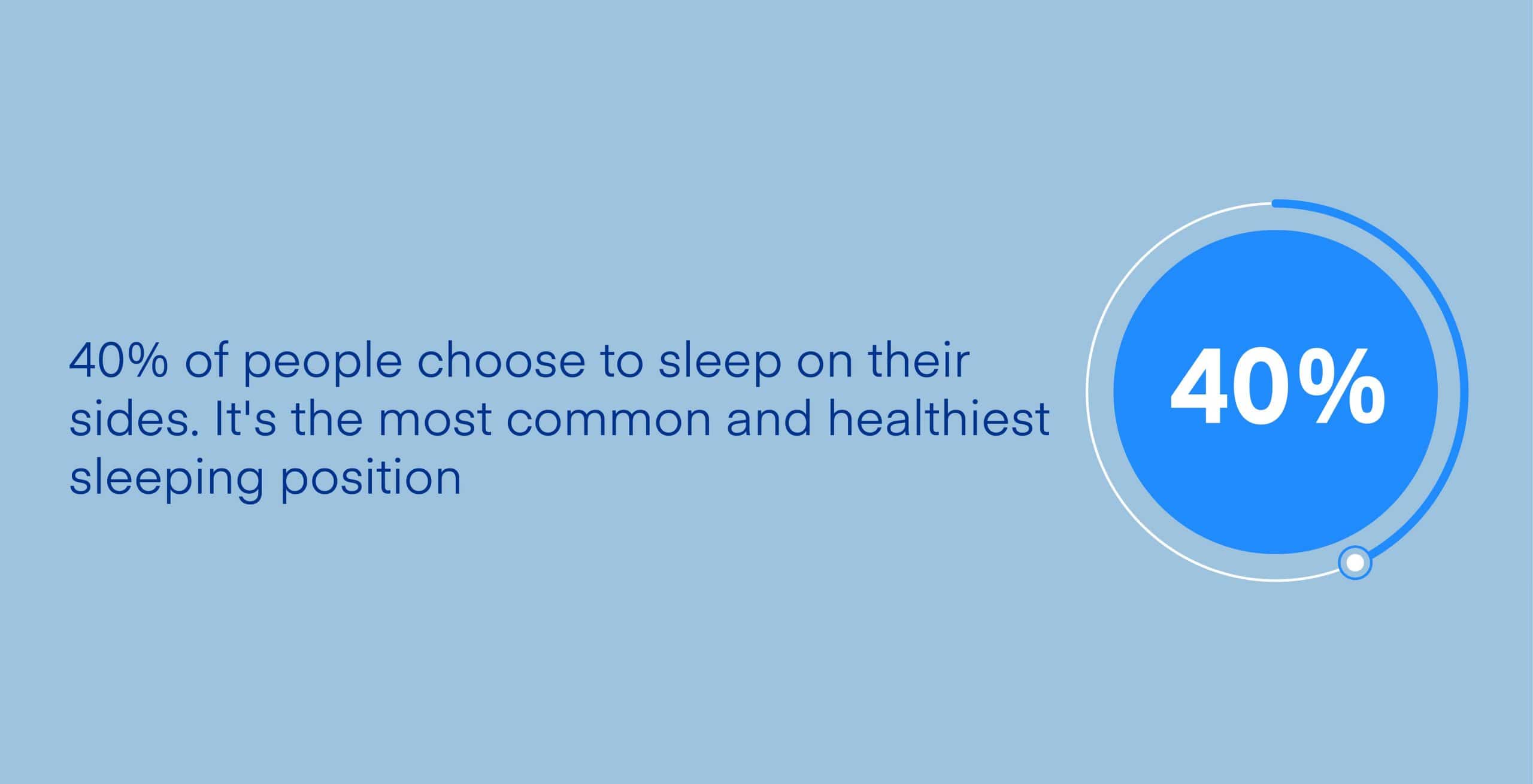
The best mattress for side sleepers can be medium, medium-soft, or even soft, as long as it offers plenty of support. Since hybrids are typically medium or medium-firm, side sleepers may have a tougher time finding a comfortable hybrid for their needs.
Back Sleepers
Back sleeping is healthy for the back and spine, but it can make snoring or sleep apnea worse. Back sleepers will be most comfortable on medium or medium-firm mattresses since these give the best balance of support and cushioning. It’s easy to find a hybrid within this firmness range; however, back sleepers should consider the comfort layers in their hybrids to avoid too much sinkage.
Since back sleepers typically prefer a medium to medium-firm mattress, hybrids are a great option since most of them are available in this firmness range.
Stomach Sleepers
Sleeping on the stomach is one of the least popular positions, but it’s still the favorite for a few people. We don’t recommend sleeping this way because it puts so much pressure on the neck, back, shoulders, and hips— the only way to avoid misalignment or injury is to choose a firm mattress. Since all hybrids are made with foam comfort layers, stomach sleepers should be wary of softer beds with lots of sink potential.
However, because hybrids are made with steel coils in the base, they create a firmer surface that could be suitable for stomach sleepers. Stomach sleepers should avoid hybrids with thick, soft comfort layers since these run the risk of sinking and throwing things out of alignment. Additionally, the coils in the base should be firm and lower-gauge.
Your Mattress Foundation
Adjustable foundations can work well with some hybrid models, providing that the mattress is not too thick. The innerspring coils inside a hybrid mattress are not as flexible as memory or latex foam, and thus don’t bend as easily on an adjustable base. If your chosen hybrid has very thick layers of comfort foam, check the company website or warranty to make sure you can use it with an adjustable bed.
Hybrids can be used with a metal frame or platform bases as well, but be careful of slatted bases— they are more compatible with memory or latex foam mattresses. Additionally, hybrids aren’t typically used with box springs because they are meant to support traditional innersprings, and beds made with foam don’t get enough support from a box spring.
Spinal alignment should be one of your first considerations when you’re getting ready to buy a mattress. An unsupportive foundation can lead to back pain, shoulder pain, and other problems, no matter your sleeping position.
Company Transparency and Policies
Beyond the mattress you choose, the brand attached to it carries a lot of weight. Try to go with an established brand— one with transparent policies and practices that publish customer reviews on their website. If you can’t seem to find negative reviews anywhere, that’s a red flag; it means the company is filtering out, or deleting, any negative reviews and making sure the most positive reviews are at the forefront of the website.
Of course, there’s nothing wrong with showcasing positive reviews, but when you can’t read about the pros and cons of a product based on real customer experience, all you have to rely on is the company’s own marketing. Look for third-party mattress reviews on other websites as well for the most comprehensive picture of the mattress brand and product.
Sleep Trial
Sleep trials accompany most bed in a box mattress brands, and that includes brands that sell hybrid beds. It takes about 30 days to adjust to a new mattress, which happens to be the standard trial period for most online brands. In fact, most companies offer a sleep trial at least three times that long, giving you plenty of time to decide if the mattress is a good fit.
Warranty
In the mattress industry, a good mattress should have at least a 10-year warranty; most mattresses last for about 10 years, and so a warranty this length protects the consumer for the entire time they have the mattress.
Hybrid mattresses are unique in that their warranties cover issues common with both foam and innersprings. For example:
- Sagging below a certain point (usually 1 inch)
- Burst or broken coils
- Bunched or ripped foam
Beware of brands that offer extremely long warranties, such as lifetime warranties. While they seem like a great deal, most mattresses need replacing after 10 years, and so a lifetime warranty doesn’t serve you much.
Return Policy
The return policy is attached to the sleep trial if one is offered— customers can return their mattress within the sleep trial period for a full refund. Usually, companies don’t require you to ship the mattress back— rather, they request you donate or recycle it.
If there is no sleep trial, the return policy usually comes with a customer satisfaction guarantee that allows you to return your mattress within 30 days of purchase. However, these guarantees are not really risk-free— some of them only accept returns of unopened, unused mattresses. That doesn’t give you the chance to try out the bed, and then what’s the point?
Lifespan and Durability
Even though hybrids last longer than their lower-priced innerspring counterparts, they still do not have a longer lifespan than most memory foam or latex foam mattresses. Innersprings, even when wrapped, can lead to sagging pretty early on. The good news it that most hybrid mattress warranties cover sagging up to a certain depth, but by that time you may already be too uncomfortable on the mattress.
To extend your hybrid’s lifespan, use it on a compatible foundation (as outlined in the warranty) and treat it with care! Use a mattress protector, and no matter how tempting it is, don’t jump on the bed. With good care, a quality hybrid will usually last between 6-7 years.
Cost
Maybe you think you need to have a hefty budget in order to afford a high-quality mattress. While it’s true that some mattress types are more expensive than others, most are available in different firmness levels with and without bells and whistles, giving you some more options.
Hybrids are usually more expensive than memory foam or innersprings. Even on the low-end, a hybrid can cost around $800. However, the average cost of a high-quality mattress is actually $1,000 (that’s the average cost of all mattress types combined), so you can still snag a good hybrid for a decent amount of money. Higher-end models can cost up to $4,000 or more. On average, a queen-size hybrid costs about $1,500.
Who Should Sleep on a Hybrid Mattress?
Earlier, we compared hybrids to the other mattress types, but we want to focus on the specific pros and cons of hybrid mattresses to give you the most comprehensive perspective.
Couples
Couples most often choose a medium-feel mattress because this firmness has the perfect balance of support and softness and it appeals to many sleeping positions. Many hybrid mattresses naturally have a medium or medium-firm feel because of the sturdy coils and the cushiony foam on top.
Hybrids are less noisy than innersprings, but because they are made with coils, they still have the potential to squeak. This could be a concern for anyone who shares their bed with a restless partner.
Additionally, wrapped coils in hybrids are meant to reduce motion transfer, which is another major concern when you share your bed. While wrapped coils aren’t as motion-isolating as memory foam, they are a good fit for couples who want a responsive surface without the motion transfer.
Back Pain Sufferers
Someone with regular back pain knows how much their mattress can alleviate or exacerbate this pain. A medium or medium-firm mattress has been proven to be the best firmness for decreasing back pain, busting the age-old myth that a soft mattress is the best remedy for back pain.
Those with chronic pain should choose a mattress with some kind of pressure relief— if a hybrid uses memory foam in its top layers, chances are it will relieve pressure points fairly well. Just remember to choose a hybrid that’s medium or medium-firm to prevent any sinking or misalignment.
Those Who Sleep Hot
Hybrids have coil bases, which are naturally more cooling than foam. They provide plenty of breathability and space for air to move through the mattress, so if sleeping hot is a major concern, a hybrid could be the best option for you. Keep in mind that your bedding can also affect temperature regulation at night— choose bamboo, cotton, or linen fabrics for the best breathability.
Allergy Sufferers
Hybrids don’t trap as many dust mites or allergens as innersprings do— the topmost layers, if made of foam, are naturally hypoallergenic. Always use a mattress protector or encasement to shield your mattress from potential allergens as well as spills or stains.
FAQs
Are hybrids available as beds-in-a-box?
Yes, hybrids are often sold using the bed-in-a-box model so popular today. While not as flexible or compressible as memory foam, hybrids can still be safely compressed into a box and shipped to your door. If you’re concerned about your hybrid being damaged due to it being put in a box, contact the brand’s customer service representatives for more information.
Do hybrids trap heat like foam beds?
One of the most common complaints associated with memory foam mattresses is that they trap heat; memory foam naturally traps heat because of its construction. However, to combat this issue, many companies infuse their foams with gel, copper, or graphite, which draw away body heat and keep it out of the mattress.
Many hybrids utilize gel-foam or other cooling foams in their comfort layers for this same reason. If temperature regulation is an issue for you, look for hybrids with cooling foams.
Do hybrids resist sagging?
Hybrids are made with innerspring coils, which have been known to cause premature sagging. However, hybrids are also made with reinforced layers of foam to prevent this issue. If you’re worried, read customer reviews from customers who have owned their mattress for at least 3 months— this will give you a better idea of how the mattress holds up to repeated use.
What makes Amerisleep’s hybrid mattresses different
Amerisleep hybrid mattresses feature plant-based memory foams and offer targeted, zoned support to deliver better sleep. Our hybrid mattresses range in firmness and are tailored towards types of sleepers (rather than budget sizes)—so you can easily find an Amerisleep hybrid compatible with your sleep needs. Plus, because we sell our hybrids direct-to-consumer, they’re priced at a fraction of the cost many mattress retailers charge for their mattress models.
Are Amerisleep hybrid mattresses hypoallergenic?
We use CertiPUR-US® certified, plant-based memory foams in our mattresses so that they’re hypoallergenic and safe for sleepers of all ages.
How much does an Amerisleep hybrid mattress cost?
We carry three hybrid mattresses (AS2h, AS3h, and AS5h) which range in price from $1119 to $1679 (for queen sizes).
Does an Amerisleep hybrid mattress reduce back pain?
Amerisleep hybrid mattresses feature a spring coil base that is zoned to give you firmer support in the areas you need it most. The firmness in these areas helps to support your lumber and prevent back pain. The zones around the hips and shoulders are more elastic, so you still get adequate support, but you also get a deeper compression. This works to prevent painful pressure points from forming near these sensitive areas. It also helps to keep the spine in alignment, which can also help reduce back pain.
How long is the Amerisleep sleep trial?
Every Amerisleep mattress comes with a 100-night sleep trial, giving you a few months to try your new bed at home and determine if its a fit. If you decide against it, please give us a call and we’ll initiate an exchange or process a return.
What is better, a memory foam or hybrid mattress?
Choosing between a memory foam or hybrid mattress comes down to personal preference. Memory foam mattresses are ideal for sleepers looking for a “cloud-like” or “cradling” sleep experience and crave the comfort of foam layers. Hybrids are better-suited for sleepers who prefer a bouncier mattress but still want or need the pressure-relief provided by foam layers.
Why is Amerisleep the best-rated hybrid mattress?
Amerisleep is highly-rated because we design our mattress models for types of sleepers and are dedicated to connecting customers with the best mattress for their sleep needs. We understand there’s no “one-size-fits-all” mattress out there, which is why we strive to offer our customers variety. Plus, we use high-quality, long-lasting materials in each of our beds to help you get the most for your money.
Are you ready to find the best hybrid mattress?
Remember that a hybrid is not a combination of other types of foams in one mattress (also called a “foam hybrid”)— a true hybrid must have both coils and foam. Hybrids typically have a medium to medium-firm feel, are bouncier than memory foam beds, and they usually cost more, too. If hybrids utilize eco-friendly materials such as organic cotton or other natural materials, that can influence the cost, as well.
No matter what you choose, make sure that your hybrid mattress will support your back, maintain a healthy sleeping posture, and leave you waking up refreshed and ache-free. The best hybrid mattress will give you a good night’s rest without wearing down after years of use.
About the author
McKenzie Hyde is a Certified Sleep Science Coach and a full-time writer focused on sleep health and the mattress industry. She currently writes articles on a variety of topics, ranging from sleep hygiene to the newest trends in the mattress and bedding industry. Just some of the topics she has covered include best sleep practices for students, the consequences of going without sleep, and choosing the right bed if you suffer from back pain. McKenzie Hyde holds a Master of Arts degree from Utah State University where she studied literature and writing. While there, she taught argumentative writing and wrote a variety of articles and analyses for literary and academic journals.
View all posts
